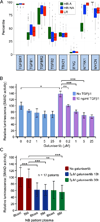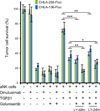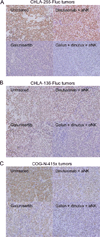TGFβR1 Blockade with Galunisertib (LY2157299) Enhances Anti-Neuroblastoma Activity of the Anti-GD2 Antibody Dinutuximab (ch14.18) with Natural Killer Cells
- PMID: 27756784
- PMCID: PMC5361893
- DOI: 10.1158/1078-0432.CCR-16-1743
TGFβR1 Blockade with Galunisertib (LY2157299) Enhances Anti-Neuroblastoma Activity of the Anti-GD2 Antibody Dinutuximab (ch14.18) with Natural Killer Cells
Abstract
Purpose: Immunotherapy of high-risk neuroblastoma using the anti-GD2 antibody dinutuximab induces antibody-dependent cell-mediated cytotoxicity (ADCC). Galunisertib, an inhibitor of TGFβR1, was examined for its ability to enhance the efficacy of dinutuximab in combination with human ex vivo activated NK (aNK) cells against neuroblastoma.
Experimental design: TGFB1 and TGFBR1 mRNA expression was determined for 249 primary neuroblastoma tumors by microarray analysis. The ability of galunisertib to inhibit SMAD activity induced by neuroblastoma patient blood and bone marrow plasmas in neuroblastoma cells was tested. The impact of galunisertib on TGFβ1-induced inhibition of aNK cytotoxicity and ADCC in vitro and on anti-neuroblastoma activity in NOD-scid gamma (NSG) mice was determined.
Results: Neuroblastomas express TGFB1 and TGFBR1 mRNA. Galunisertib suppressed SMAD activation in neuroblastoma cells induced by exogenous TGFβ1 or by patient blood and bone marrow plasma, and suppressed SMAD2 phosphorylation in human neuroblastoma cells growing in NSG mice. In NK cells treated in vitro with exogenous TGFβ1, galunisertib suppressed SMAD2 phosphorylation and restored the expression of DNAM-1, NKp30, and NKG2D cytotoxicity receptors and the TRAIL death ligand, the release of perforin and granzyme A, and the direct cytotoxicity and ADCC of aNK cells against neuroblastoma cells. Addition of galunisertib to adoptive cell therapy with aNK cells plus dinutuximab reduced tumor growth and increased survival of mice injected with two neuroblastoma cell lines or a patient-derived xenograft.
Conclusions: Galunisertib suppresses activation of SMAD2 in neuroblastomas and aNK cells, restores NK cytotoxic mechanisms, and increases the efficacy of dinutuximab with aNK cells against neuroblastoma tumors. Clin Cancer Res; 23(3); 804-13. ©2016 AACRSee related commentary by Zenarruzabeitia et al., p. 615.
©2016 American Association for Cancer Research.
Conflict of interest statement
Figures





Comment in
-
Natural Killer Cells to the Attack: Combination Therapy against Neuroblastoma.Clin Cancer Res. 2017 Feb 1;23(3):615-617. doi: 10.1158/1078-0432.CCR-16-2478. Epub 2016 Nov 21. Clin Cancer Res. 2017. PMID: 27872101
Similar articles
-
Anti-CD105 Antibody Eliminates Tumor Microenvironment Cells and Enhances Anti-GD2 Antibody Immunotherapy of Neuroblastoma with Activated Natural Killer Cells.Clin Cancer Res. 2019 Aug 1;25(15):4761-4774. doi: 10.1158/1078-0432.CCR-18-3358. Epub 2019 May 8. Clin Cancer Res. 2019. PMID: 31068371 Free PMC article.
-
Combinatorial immunotherapy of N-803 (IL-15 superagonist) and dinutuximab with ex vivo expanded natural killer cells significantly enhances in vitro cytotoxicity against GD2+ pediatric solid tumors and in vivo survival of xenografted immunodeficient NSG mice.J Immunother Cancer. 2021 Jul;9(7):e002267. doi: 10.1136/jitc-2020-002267. J Immunother Cancer. 2021. PMID: 34244307 Free PMC article.
-
Activated Natural Killer Cells in Combination with Anti-GD2 Antibody Dinutuximab Improve Survival of Mice after Surgical Resection of Primary Neuroblastoma.Clin Cancer Res. 2019 Jan 1;25(1):325-333. doi: 10.1158/1078-0432.CCR-18-1317. Epub 2018 Sep 19. Clin Cancer Res. 2019. PMID: 30232225 Free PMC article.
-
Clinical development of galunisertib (LY2157299 monohydrate), a small molecule inhibitor of transforming growth factor-beta signaling pathway.Drug Des Devel Ther. 2015 Aug 10;9:4479-99. doi: 10.2147/DDDT.S86621. eCollection 2015. Drug Des Devel Ther. 2015. PMID: 26309397 Free PMC article. Review.
-
Combination therapy with interleukin-2 and antitumor monoclonal antibodies.Cancer J Sci Am. 1997 Dec;3 Suppl 1:S121-7. Cancer J Sci Am. 1997. PMID: 9457407 Review.
Cited by
-
Tumor-induced neurogenesis and immune evasion as targets of innovative anti-cancer therapies.Signal Transduct Target Ther. 2020 Jun 18;5(1):99. doi: 10.1038/s41392-020-0205-z. Signal Transduct Target Ther. 2020. PMID: 32555170 Free PMC article. Review.
-
Harnessing natural killer cells for cancer immunotherapy: dispatching the first responders.Nat Rev Drug Discov. 2022 Aug;21(8):559-577. doi: 10.1038/s41573-022-00413-7. Epub 2022 Mar 21. Nat Rev Drug Discov. 2022. PMID: 35314852 Free PMC article. Review.
-
TGFβ Imprinting During Activation Promotes Natural Killer Cell Cytokine Hypersecretion.Cancers (Basel). 2018 Nov 5;10(11):423. doi: 10.3390/cancers10110423. Cancers (Basel). 2018. PMID: 30400618 Free PMC article.
-
TGFβ-Directed Therapeutics: 2020.Pharmacol Ther. 2021 Jan;217:107666. doi: 10.1016/j.pharmthera.2020.107666. Epub 2020 Aug 21. Pharmacol Ther. 2021. PMID: 32835827 Free PMC article. Review.
-
Signaling Pathways Tuning Innate Lymphoid Cell Response to Hepatocellular Carcinoma.Front Immunol. 2022 Feb 23;13:846923. doi: 10.3389/fimmu.2022.846923. eCollection 2022. Front Immunol. 2022. PMID: 35281021 Free PMC article. Review.
References
-
- Wilson EB, El-Jawhari JJ, Neilson AL, Hall GD, Melcher AA, Meade JL, et al. Human tumour immune evasion via TGF-beta blocks NK cell activation but not survival allowing therapeutic restoration of anti-tumour activity. PLoS One. 2011;6(9):e22842. PubMed PMID: 21909397; PMCID: PMC3167809. - PMC - PubMed
-
- Massagué J, Blain SW, Lo RS. TGFbeta signaling in growth control, cancer, and heritable disorders. Cell. 2000;103(2):295–309. PubMed PMID: 11057902. - PubMed
-
- Padua D, Massagué J. Roles of TGFbeta in metastasis. Cell Res. 2009;19(1):89–102. PubMed PMID: 19050696. - PubMed
MeSH terms
Substances
Grants and funding
LinkOut - more resources
Full Text Sources
Other Literature Sources
Medical
Research Materials
Miscellaneous

